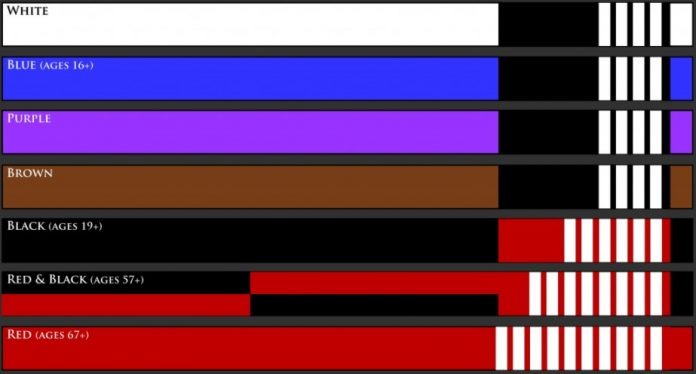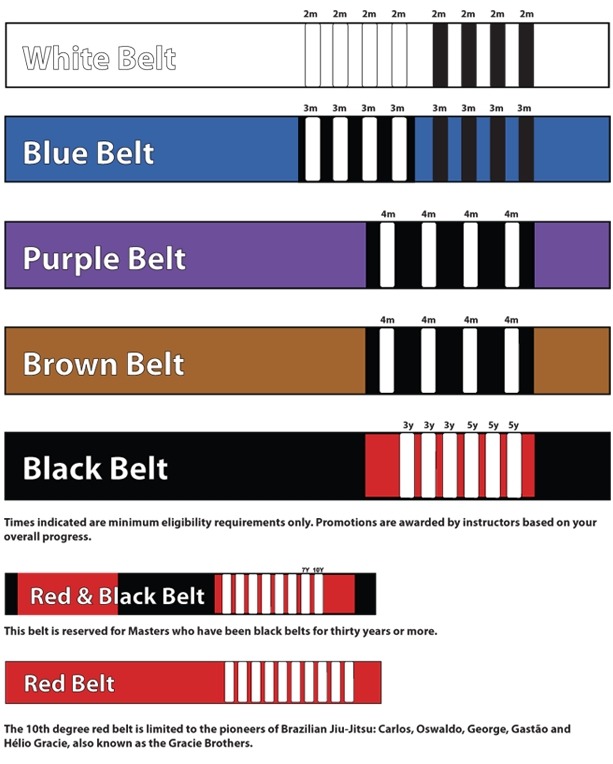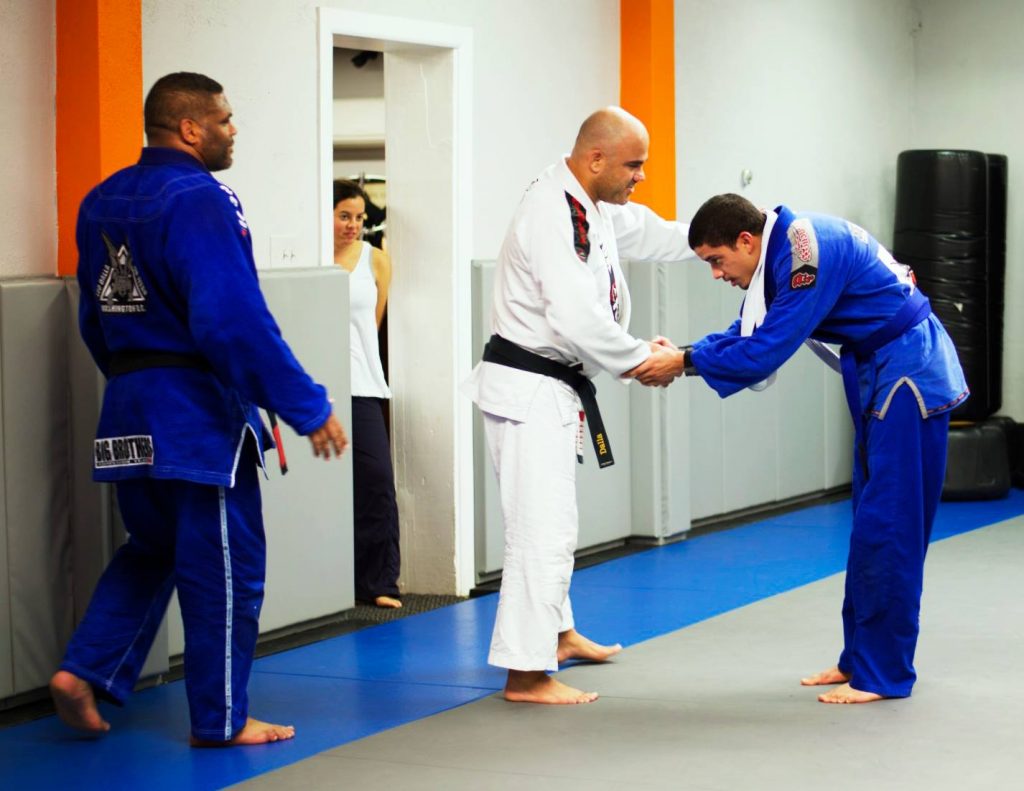
Are you aware of the history of the BJJ belt system? Do you know how to properly tie your Jiu-Jitsu belt? How about buying the best BJJ belt for you? What about your belt and your progress in BJJ? Do you know everything about Jiu-Jitsu belt levels or jiu-jitsu belt rankings? What should you focus on? And of course, the answer to the always-burning question, should you wash your BJJ belt? The answers to all these questions as well as plenty more are included in the following article. So, dig right in!
Unlike many other martial arts, BJJ takes a very long time to master. So much so, that by the time a practitioner reaches the black belt, they’re known as “professors”. The gentle art is so complex that true understanding actually starts after you get the black belt. During the years that lead to the ultimate reward, students go through a ranking system marked by different belts. From promotion ceremonies to the knowledge required, Jiu-Jitsu belts are true milestones that reflect hard work and dedication. This is reflected in a very real BJJ belt system.
In this article, we’ll take a trip from the origins of the BJJ belt system to the ways you can tie a belt. We’ll also look at which brands of Jiu-Jitsu belts are considered the best, as well as the traditional promotion ceremony. So, without further ado, let’s jump in.
Background Of The Jiu-Jitsu Belt System
The belts originate in ancient China, where they had but one role – to stop trousers from falling. During their evolution, mostly as a utility for carrying weapons, a system of different colors emerged. Originally, different colors illustrated social status clan affiliate or even martial arts style.
In Japanese culture, only two colors, symbolizing life and death, were used. White was for beginners, while black marked mastery. White, to the Japanese, symbolizes death, so a white belt and Gi meant students are ready to sacrifice themself and accept the high standards of a martial arts lifestyle. Black meant the student had overcome the fear of death.
The colors of the Brazilian Jiu-Jitsu belt system known today are attributed to Judo’s founder Dr. Jigoro Kano. His motive behind the development of such a system was to be able to visually track his students’ progress. The belt system was later adopted by Gichin Funakoshi, founder of Karate, as well as his student Byung Jick Ro who developed Taekwondo. During the early days of belt ranking, students only had one belt, which started with white belts. After every promotion, they dyed their belt a darker color. The darker color both signified maturity within the art and was a practical dying solution.
Jiu-Jitsu Belts System
BJJ makes use of the basic belt system that most martial artists use today. As we said earlier this system was formed around 1885 making it about 130 years old. This makes it a part of modern martial arts, seeing as some of the arts date back more than 2.000 years. The BJJ belt system is even a smaller drop in the ocean of fighting styles.

So, what was the point of practicing martial arts before belts came into the forefront? Mostly it was for the same reasons people walk into a BJJ academy nowadays. Self-defense, building the warrior spirit, even preserving cultural heritage. Some did it as an extension of family duty, not much different from what the Gracies did years later.
BJJ Belt System
In terms of the Brazilian Jiu-Jitsu belt, you shouldn’t expect a new belt every few months. BJJ is notoriously strict when it comes to belt promotions. Well, at least in theory. Unfortunately, business seems more important to some people than the true spirit of BJJ. Apart from some “belt buying” incidents, the average practitioner is going to need at least 10 years to reach the black belt.
-
Brazilian Jiu-Jitsu Belt For Kids
Kids start off with the traditional white, just like adults. That said, once they go through all the kids’ belts, they do not begin again from white as adults. They simply carry one as if they were white, and begin their adult journey from a blue belt. In terms of age, kids’ belts are applicable from the age of 4, up to the age of 17.
Kids in that age span have to go through white, gray, yellow, orange, and green. After green, they can go straight to blue and continue through the adult belt system. All belts come with accompanying stripes. In modern times, in cases of kids that have been training since 4, the BJJ belt system can get a bit more complicated. Namely, their grey belt might have a lengthwise white stripe, that gets removed after four additional stripes. Conversely, every other belt has a lengthwise stripe of different color, signifying that the kid still has to work to earn a clear-colored belt.
The inclusion of such a complicated BJJ belt system of belts varies from academy to academy. It is mostly based on affiliation with a major BJJ organization.
-
The Adult BJJ Belt System
The first belt that adults get promoted to after white, is blue. It is never as easy though as just writing it in a sentence. White belt is a time of horror. You know those dreams where you run and you can’t outrun your attacker no matter what you do? Well, being a white belt is much like that, just in real life. there’s a huge reward at the end, though in the first major milestone – the blue belt.
Blue belt is the time when a practitioner builds their defensive game and learns how to integrate moves together. It is the perseverance belt. The blue belt is arguably the most important part of the BJJ belt system. It is also, very often, the longest people spend at a single belt. The purple belt is in the middle of the road. This is when the majority of one’s BJJ style is defined. It is at the purple belt that people tend to choose a direction of specialization while also staying well-rounded.
Just preceding mastery is the brown belt, a time of profound technical knowledge and a complex but simple game. Whether it is top or bottom, a brown belt is going to be dangerous and merciless. The period between purple and brown is also when most people begin teaching Jiu-Jitsu. This is the period when you start giving back to the art in two different ways. First, you’re going to teach new students in the ways of the at. Secondly, you’re most likely to have some signature moves and variations by now that go directly into the pool of common BJJ knowledge.
-
Black belt And Beyond
For those that have been black belts for at least 31 years, there are still further milestones to achieve. Coral Belts (red and black) represent the penultimate level of proficiency in the art. Still, there’s more. The highest available belt is the Red Belt, with the 10th-degree red belt only meant for pioneers of BrazilianJiu-Jitsu. Click the links to see the list and learn everything about BJJ RED BELTS and BJJ CORAL BELTS
-
Belt Promotion Ceremony
The promotion ceremony itself is a source of much controversy in the BJJ community. As gentle as the art may be (in name, at least) the promotion ceremony tradition is anything but. The “traditional” style involves a gauntlet of everyone in the academy, bashing the newly promoted student with their belts. Many schools these days are disbanding this painful tradition, spurring debates in the community.
In all honesty, the founders themselves. never really endorsed this tradition. However, nowadays it seems to be the norm rather than the exception. Lots of schools even have their own version of it, some more violent than others. Frankly, it is a violent tradition that has little to do with the spirit of BJJ. However, it is a warrior’s rite of passage, and as such some consider it an integral part of grappling. What’s your take on it?
What about You and your Brazilian Jiu-Jitsu belt?
You start BJJ and the moment you line up for your first class all you want is to be on the other end of the line. Once you manage to become a purple/brown belt and get to the top of the line, your desires change. Now you want to stand opposite, where the instructors are and you want a black belt. Once you’re there, though, you’ll understand that a BJJ belt doesn’t really matter much. Even more so, you’ll want to be at the beginning of the line once again. If you ask me being a white belt is such a great feeling. You’re looking at all those higher belts with such a hunger that any time you dominate them or submit them makes you feel so good 🙂
The fact is we all want to get Black Belt as fast as possible. The beginners are often much more grounded and are going to be satisfied with a blue belt like most blue belts or any colored BJJ belt for that matter. The trouble with BJJ belts, though, is that they fade. The stitching gets loose, the color fades and all you’re left with is a white belt once again. On the other hand, your knowledge and experience take a completely different direction. This is the stuff that’s not going to fade. Yes, you’ll lose the edge if you stop training, but you won’t lose your knowledge and understanding of Jiu-JItsu. You also won’t lose the family you met while you were hunting all those different colored BJJ belts.
What is the reason why you started Brazilian Jiu-Jitsu in the first place? Perhaps it was self-defense advice you were searching for. Or maybe you just wanted to stay in shape in a different way. There’s always the option that a friend got you interested and you had to try this cool new thing out. In truth, all these are legitimate reasons. Regardless of the reasons, your goals during your BJJ journey are going to change at least a few times. From going through the BJJ belts all the way to discovering the things that really matter.
Basically, you won’t get much for free in today’s world just because you’re a multi-Dan black belt. Of course, your accomplishment is worthy of praise, but if you’ve gotten that far just because of that you’ve completely missed the point of Jiu-Jitsu. The BJJ belt system is there to guide you toward your real goals, not to be a goal in itself.
Focus On What Truly Matters
Thinking only about the next promotion is very normal during the first few years of BJJ. Especially until you get out of the white belt zone. Ideally, you shouldn’t worry at all about BJJ belts. However, in practice, it is acceptable to have the blue and even purple belt as the sole goal of your BJJ journey. Chasing BJJ belts after that though is a sign that you’re probably in the wrong martial art.

It is perfectly fine to work hard for achieving your black belt. Just remember that there are other BJJ belts even past the black and you’ll be in it for a lifetime. Even then, you won’t be able to discover it ends. Learn the art. Become a better human being. Become a teacher. Compete and travel the world. Grow together along with your Jiu-Jitsu family and learn to have a correct attitude both on and off the mats.
When should BJJ Competitors go for higher Belt?
If you’re a competitor you shouldn’t be in any hurry of getting a higher belt. Your focus and desire of progressing in the BJJ Belt System should be minimal. Why is that so? You want to get experience in tournaments. Imagine you get a blue belt with only a few fights in white and 6-7 months of training? You didn’t build your confidence, you’re still searching for your game, etc… And when you come to blue belts you’ll fight guys with 2-5 years of training, much more experienced in competition than you are. You’ll eventually lose a lot of matches asking yourself what did you do wrong and the answer is simple. You shouldn’t be there in the first place.
So, why would you hurry? Unless you’re as talented as Caio Terra or some other 3 years of training Black belts take your time and enjoy. Once you’re easily dominating opponents on your belt level on few tournaments that’s the time for you to go for a higher rank.
Shopping For A BJJ Belt
When it comes to buying Jiu-Jitsu belts, much like with a BJJ Gi, there are certain brands that are clear favorites among grapplers. The main difference between Jiu-Jitsu belts and those of other martial arts is the presence of a black/red bar on one end. Some of the best brands for 2021 include Tatami, Venum, Fuji…
Check out our list of The Best BJJ GI in 2023.

Tying The BJJ Knot
When training BJJ, your belt is going to get loose. It’s one of the few things that are certain to happen during every class. That, however, is not a reason to skip tying your belt properly. It is one of the things that you have to learn during your first weeks of training. A properly tied belt is a sign of respect which is very important in Jiu-Jitsu. It is also a sign of personal preference. There are different methods of tying Jiu-Jitsu belts that different people like for different occasions.
For example, the regular way to tie a BJJ belt is not different from the traditional Japanese style. This is a mark of tradition and honors the original spirit of BJJ. More modern versions include options that prevent the belt from coming loose during rolling or in competition. This is particularly good for tournaments because a loose belt can be a liability. There are also some hybrid styles as well as the Helio Gracie style. Check out the video below and choose the style that best fits you. Just don’t be that guy/girl that does freestyle knots that look completely out of place on the mats.
Check out the article on how to tie your belt in many different ways. Also, check an article on Jiu-Jitsu Belts Explained in numerous ways.
And PLEASE, do wash your belt regularly!!! It’s a question of hygiene, not just misplaced superstition.
Related Articles:
The Best BJJ GI of 2018
Things To Look For When Choosing A BJJ School
BJJ Mental Attitude For Each Belt Level
Tips On Rolling With Higher Ranked Jiu-Jitsu Belts
Common Blue Belt Mistakes Caused By Bad White Belt Habits
John Danaher’s Definition of Jiu-Jitsu as a Four Steps System


![Darce Choke Encyclopedia – Origins, Mechanics and Variations [2025] BJJ, choke, Brabo, BJJ Darce Choke, D'arce Choke, Darce BJJ Choke](https://bjj-world.com/wp-content/uploads/2017/11/JungPoirierLeeYahoo-218x150.jpg)












![Slicin’ Calves Mikey Musumeci DVD Review [2025] Slicin' Calves Mikey Musumeci DVD Review](https://bjj-world.com/wp-content/uploads/2025/04/slicin-calves-mikey-musumeci-dvd-review-218x150.png)
![Jiu-Jitsu For Old Guys Guard Retention Bernardo Faria DVD Review [2025] Jiu-Jitsu For Old Guys Guard Retention Bernardo Faria DVD Review](https://bjj-world.com/wp-content/uploads/2025/03/old-guys-guard-retention-bernardo-faria-dvd-review-218x150.png)
![X-Guard Trickery Kyle Sleeman DVD Review [2025] X-Guard Trickery Kyle Sleeman DVD Review](https://bjj-world.com/wp-content/uploads/2025/03/x-guard-trickery-kyle-sleeman-dvd-review-218x150.png)
![Countering with Crab Ride Anthony Budion DVD Review [2025] Countering with Crab Ride Anthony Budion DVD Review](https://bjj-world.com/wp-content/uploads/2025/03/countering-with-crab-ride-anthony-budion-dvd-review-218x150.png)

![Understanding The Distance On Top Gui Mendes DVD Review [2024] Understanding The Distance On Top Gui Mendes DVD Review](https://bjj-world.com/wp-content/uploads/2024/10/distance-on-top-gui-mendes-dvd-review-100x70.png)



![Dima Murovanni Kill The Collar Tie BJJ Trendsetters DVD Review [2024] Dima Murovanni Kill The Collar Tie BJJ Trendsetters DVD Review](https://bjj-world.com/wp-content/uploads/2024/09/dima-murovanni-kill-the-collar-tie-dvd-review-100x70.png)



![No-Gi Pressure Mastery JT Torres DVD Review [2024] No-Gi Pressure Mastery JT Torres DVD Review](https://bjj-world.com/wp-content/uploads/2024/10/no-gi-pressure-mastery-jt-torres-dvd-review-100x70.png)

![Two Sides One Game Sweep and Pass Marcos Tinoco DVD Review [2024] Two Sides One Game Sweep and Pass Marcos Tinoco DVD Review](https://bjj-world.com/wp-content/uploads/2024/11/sweep-and-pass-marcos-tinoco-dvd-review-100x70.png)
![Daisy Fresh WHITE BELT Wrestling Curriculum DVD Review [2024] Daisy Fresh WHITE BELT Wrestling Curriculum DVD Review](https://bjj-world.com/wp-content/uploads/2024/10/daisy-fresh-white-belt-wrestling-curriculum-review-100x70.png)

![Weight Training For Grappling Michael Israetel DVD Review [2025] Weight Training For Grappling Michael Israetel DVD Review](https://bjj-world.com/wp-content/uploads/2025/01/weight-training-for-grappling-michael-israetel-dvd-review-100x70.png)
![Guard Busters Bill Cooper BJJ DVD Review [2025] Guard Busters Bill Cooper BJJ DVD Review](https://bjj-world.com/wp-content/uploads/2025/03/guard-busters-bill-cooper-bjj-dvd-review-100x70.png)





![Position And Submission Escapes Craig Funk DVD Review [2025] Position And Submission Escapes Craig Funk DVD Review](https://bjj-world.com/wp-content/uploads/2025/02/position-and-submission-escapes-craig-funk-dvd-review-100x70.png)
![Reverse De La Riva System Mikey Musumeci DVD Review [2024] Reverse De La Riva System Mikey Musumeci DVD Review](https://bjj-world.com/wp-content/uploads/2024/11/reverse-de-la-riva-system-mikey-musumeci-dvd-review-100x70.png)

![Upper Body Chain Attacks Janine Mocaiber DVD Review [2025] Upper Body Chain Attacks Janine Mocaiber DVD Review](https://bjj-world.com/wp-content/uploads/2025/03/upper-body-chain-attacks-janine-mocaiber-dvd-review-100x70.png)
![Complete Front Headlock System Michael Pixley DVD Review [2024] Complete Front Headlock System Michael Pixley DVD Review](https://bjj-world.com/wp-content/uploads/2024/10/front-headlock-system-michael-pixley-dvd-review-100x70.png)
![Zen Guide To Submission Grappling Margot Ciccarelli DVD Review [2025] Zen Guide To Submission Grappling Margot Ciccarelli DVD Review](https://bjj-world.com/wp-content/uploads/2025/02/submission-grappling-margot-ciccarelli-dvd-preview-100x70.png)
![Effectively Passing The Guard Luke Griffith DVD Review [2025] Effectively Passing The Guard Luke Griffith DVD Review](https://bjj-world.com/wp-content/uploads/2025/01/passing-the-guard-luke-griffith-dvd-review-100x70.png)

